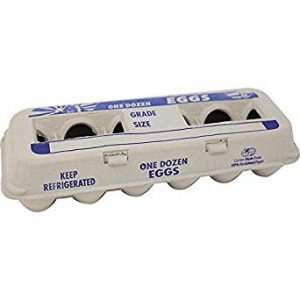 If you’re confused about the dates you see on egg cartons, it’s not surprising. Food product dating is hard to understand. One of the more puzzling facts is that none of the dates on food packages — not even “use by” dates — are an indication of food safety. Instead, package dates refer to product quality.
If you’re confused about the dates you see on egg cartons, it’s not surprising. Food product dating is hard to understand. One of the more puzzling facts is that none of the dates on food packages — not even “use by” dates — are an indication of food safety. Instead, package dates refer to product quality.
An “expiration” or “sell by” date on some egg cartons helps to ensure that the eggs are fresh by informing the grocery store not to sell the eggs after the marked date. These dates are also intended to encourage you to use the eggs when they’re still at their highest quality. An expiration date on the carton is not required but, if one is used, it can be no more than 30 days after the eggs were packed. Since the packer or retailer may choose a date under 30 days, your local retailer can give you more complete information about how many days a “sell by” or “expiration date” allows after packing.
Some cartons show a Julian date on the short side of the carton. The Julian date is the day the eggs were packed — starting with 001 as Jan 1 and ending with 365 for December 31. For example, eggs packed on June 15 would be marked 166. Some other egg packers print an open “use by” date — July 15, for example — right on the eggshell itself. If properly refrigerated, shell eggs will keep with insignificant quality loss for at least four to five weeks after the Julian or pack date. If there is no Julian or pack date, using your eggs within three weeks of purchase will allow for the possibility that your eggs may have been temporarily warehoused by the retailer before you bought them.
Why isn’t safety a factor in these dates? Food safety depends on many things, including how you handle and store eggs and other foods. Both quality and safety changes can happen before or after the date on a package. For example, if you put a fully-cooked deli ham and a carton of eggs in the trunk of your car on a hot day and then run several errands before you refrigerate the ham and eggs at home, you’ve both reduced the ham’s and eggs’ shelf-life and increased your risk of food-borne illness — no matter what the package dates say.
Even when eggs are refrigerated, time causes a quality difference, too, especially in appearance. As eggs age, the whites thin and the yolks flatten. This means that the eggs will spread more in a pan if you fry them and there will be more “angel wings” of white in the water if you poach them. Because the yolk membranes also weaken with age, the yolks may break whether you want them to or not.
For recipes where shape isn’t important, particularly when whites and yolks are beaten together, you can still use the eggs. The weakening of the yolk membrane, however, makes it easier for bacteria — if they’re present — to reach the nutritious yolk. So, to prevent the possibility of foodborne illness, it’s best to use older eggs in fully cooked items, such as quiches, stratas and baked goods.
When correctly handled, eggs have a fairly long shelf-life compared to other perishable foods. For both quality and safety, simply keep eggs refrigerated and cook them properly.
If you love to cook, consider creating your very own family cookbook at www.FamilyCookbookProject.com. We make it easy to turn a collection of recipes from family and friends into a beautiful family cookbook!
Bill Rice is Co-Publisher of the Great Family Cookbook Project, a website that helps families and individuals collect and share food memories. Follow us on Facebook and Pinterest!
